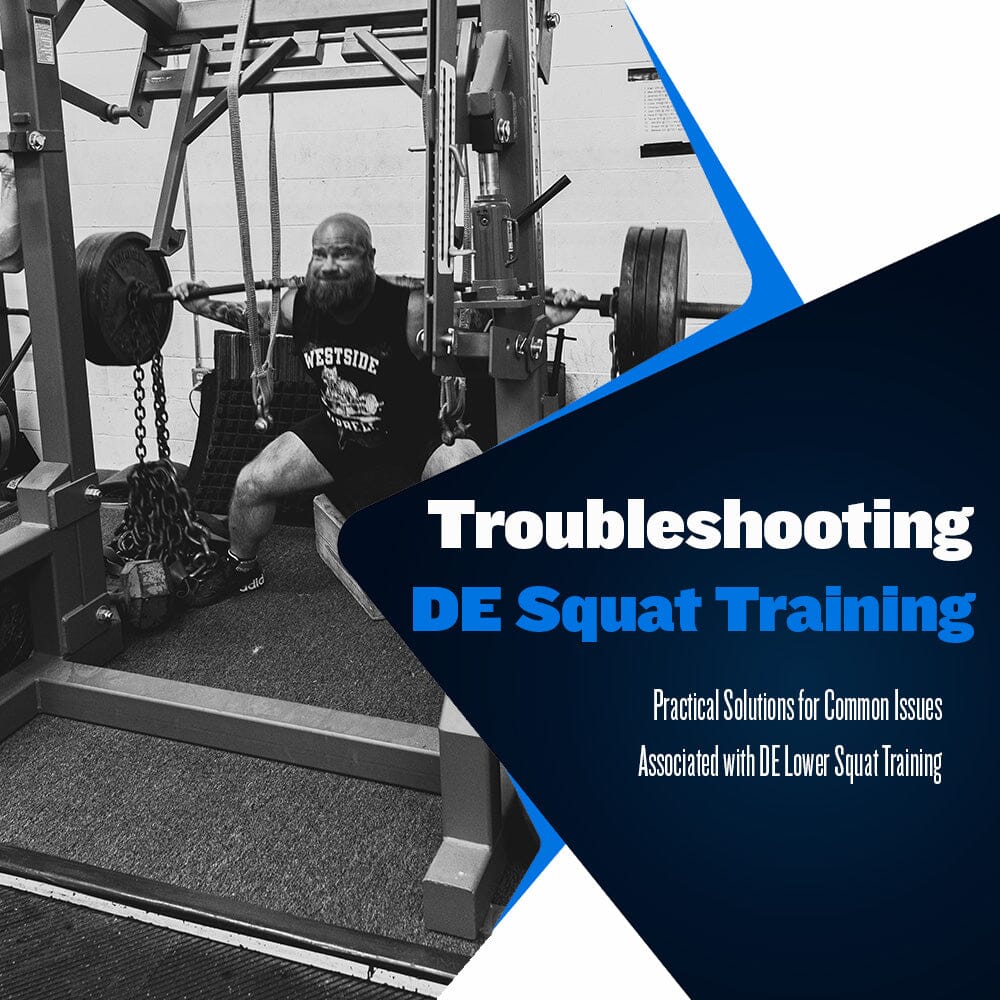Troubleshooting Dynamic Effort Squat Training

The dynamic effort method is a training method used weekly at Westside Barbell. Implementing the dynamic effort method aims to train speed-strength and enhance an athlete’s rate of force development. The dynamic effort method is a vital part of the Conjugate Method equation, considering the impact this training has on multiple athletic traits and abilities.
However, this is not the only benefit of this type of training. Dynamic effort training days typically feature a reasonable amount of training volume, making this day a valuable contributor to the overall training volume of an athlete.
Dynamic effort training must be performed for an athlete to reap the maximum rewards of max effort training. Max-effort training improves absolute strength, which is the maximum amount of force an athlete can produce. Dynamic effort training improves the rate of force development, which is the amount of time it takes to produce that force. When you effectively combine the two, you have an extremely strong and explosive athlete.
However, there may come a time when you run into an issue or roadblock in your dynamic effort training for which you may need a solution. For the sake of this article, we will focus on troubleshooting common issues athlete’s have when programming and performing dynamic effort squat training.
Common Issue #1: Inadequate Barbell Velocity
This is the most common mistake when using the dynamic effort method; slow barbell velocity. As a beginner, you may think it is wise to constantly work with the heaviest weights regardless of the training method used. However, this is the wrong mindset when using the dynamic effort method.
For the training to be optimal, we must train at a specific intensity to allow the barbell to move at the correct velocity. This means regulating the amount of weight loaded onto the barbell to ensure the athlete can achieve the proper average velocity throughout the exercise.
The required movement speed for dynamic effort work to be most effective is an average of .8m/s. Some sets may be faster, some slightly slower, but the average barbell velocity should be .8m/s when dynamic effort training is performed. As for training intensity, we follow a three-week wave escalation of 50-55-60%, with an additional 25% accommodating resistance used each week.
Now, there could also come a time when you are abiding by the rules of the dynamic effort method and training at the proper intensity levels based on your most recent max lift, but barbell velocity is significantly slower on dynamic effort day. It is a simple fix; you will reduce your training intensity by 5% each week. After a few weeks, your ability to train at proper intensity and velocity with your most recent max should be restored.
Common Issue #2: Instability When Performing Competition-Style Squats
Another issue athletes may encounter as they work through a Conjugate Method program for the first time is a problem with maintaining stability or control during a competition-style squat. This issue is typically caused by a lack of free squats being programmed during max or dynamic effort work. As with any athletic ability, you lose it if you don’t use it.
To solve this issue, perform free squats for both max and dynamic effort training. Ideally, try to incorporate a free squat variation once every 3-5 weeks as a max effort exercise and once every third wave as a dynamic effort exercise. This will provide the training necessary to develop lasting strength and skill when performing a free squat.
Using bands too often can also affect your ability to exert control over your free squat. With the bands attached, the barbell path is almost on a track, where as long as you provide basic effort, you don’t have to worry about controlling the barbell. If you run into this issue, I suggest implementing chains as your accommodating resistance for the subsequent 2-3 waves.
Unlike the bands, which improve the stability of a loaded barbell, chains cause a loaded barbell to become less stable. The instability provided by the chains forces a lifter to execute the squat with the same level of precision necessary to perform a competition squat while improving speed-strength and RFD.
While bands are most effective for building explosive strength, you must rotate chains into your DE lower waves.
Common Issue #3: Unable to Reach Proper Depth in a Competition Squat
The final issue most commonly experienced by individuals new to the Conjugate Method is the inability to reach depth in the competition squat consistently. Now, you may think that the remedy for this issue is the same as mentioned above; free squat more often. However, this is not the primary solution.
It is recommended to use the box squat when performing DE lower squats frequently. The box squat provides valuable benefits such as static-overcome-by-dynamic and relaxed-overcome-by-dynamic training effects. Additionally, box squatting keeps the hips fresh and reduces the risk of injury to the lower body when moving the barbell at high velocities.
The solution to this issue is simple; always squat to a box set to a height that forces you to reach competition-legal depth every single rep.
When working through a Conjugate Method training program, the bulk of your squat training volume will be provided by your dynamic effort lower squat day. Failure to set your box height properly means you will ultimately train yourself to squat high. The bulk of our squat training volume is made up during DE lower squats; by failing to execute your DE squats correctly and to the legal depth, you can expect poor habits to manifest quickly in your max effort and competition lifts.
If you cannot squat the prescribed training percentages to the proper depth, you will follow the same advice as an individual having issues with barbell velocity: reduce your DE lower training percentages by 5%.
Programming and Execution are Everything
The Conjugate Method is the most effective way to train. However, without proper execution and intent, the overall effectiveness of training will be limited. To be maximally effective, the Conjugate Method requires that the individual designing the programming has a complete understanding of each method and how each method interacts with one another.
Additionally, the programmer must be able to properly guide and coach the intent and execution of the movements to ensure the athlete can reap all of the benefits of our methods.
Failure to do so will ultimately result in stagnant gains in strength and athletic performance, excessive soreness, fatigue, or injury. Despite your best efforts, you will always fail if your programming is poorly designed and your execution is lackadaisical.
Our methods require an individual to understand how we bring about specific training effects, along with the intent and output necessary during execution to ensure these training effects take place. It can take many years to fully understand the Conjugate Method, which is why Lou was adamant about combining training with reading.
Check out the WSBB Blog, where we post Conjugate-related strength training articles regularly, and our online store, where you will find many books and resources to enhance your understanding of the Conjugate Method.
Knowledge is power.
Sources:
Simmons, L. (2007). Westside Barbell Book of Methods. Westside Barbell.
Verkhoshansky, Y., & Siff, M. C. (2009). Supertraining. Verkhoshansky.





